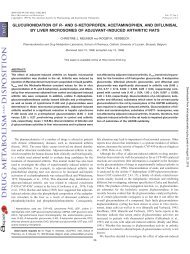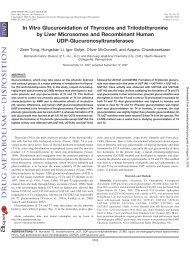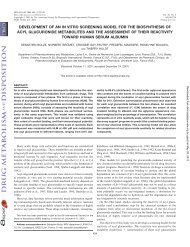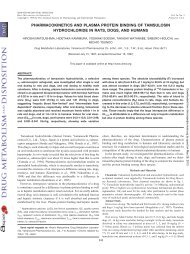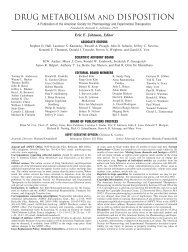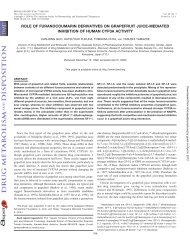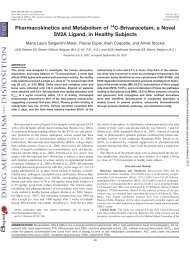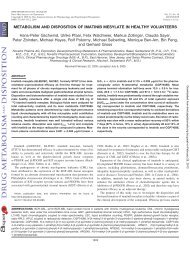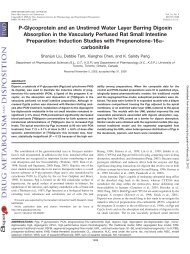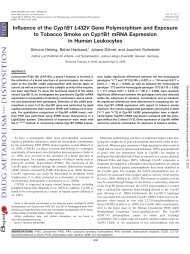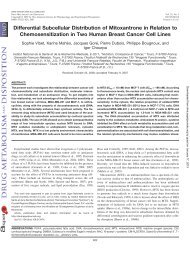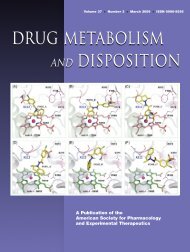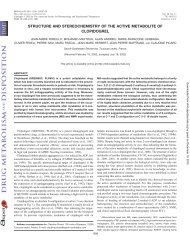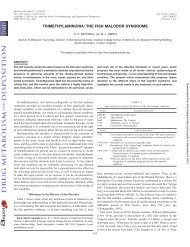DMD #048264 1 Discovery and Characterization of Novel, Potent ...
DMD #048264 1 Discovery and Characterization of Novel, Potent ...
DMD #048264 1 Discovery and Characterization of Novel, Potent ...
Create successful ePaper yourself
Turn your PDF publications into a flip-book with our unique Google optimized e-Paper software.
<strong>DMD</strong> <strong>#048264</strong><br />
the increased exposure <strong>of</strong> nisoldipine by co-administrated telmisartan could be related to<br />
CYP2J2 inhibition. It is noted nonetheless that interaction between telmisartan <strong>and</strong> the<br />
ATP-binding cassette (ABC) transporters could also contribute to the observed DDI<br />
(Weiss et al., 2010). The most recent FDA guidance for industry on drug interaction<br />
studies also suggests to include CYP2J2 when a new drug c<strong>and</strong>idate is found to be not<br />
metabolized by the major CYPs (US Department <strong>of</strong> Health <strong>and</strong> Human Services, 2012).<br />
Under the circumstances, attention should be paid on the DDI potentials for both<br />
telmisartan <strong>and</strong> flunarizine with future co-administered compounds when the metabolism<br />
<strong>and</strong> elimination <strong>of</strong> these compounds are mainly mediated by CYP2J2. Also, both<br />
telmisartan <strong>and</strong> flunarizine can be potentially used as tool drugs to assess clinically<br />
relevant metabolic DDI related to CYP2J2.<br />
Telmisartan <strong>and</strong> Flunarizine Are the First Discovered Non-substrate<br />
Inhibitor for CYP2J2. Ideally, the inhibitor that is used as a tool to study a CYP<br />
is<strong>of</strong>orm should not be the substrate <strong>of</strong> that specific CYP enzyme; otherwise, to the least it<br />
would add complexity in experimental design. For example, one has to be very careful<br />
during the course <strong>of</strong> the experiment to ensure that the reaction time is short enough so<br />
that the degradation <strong>of</strong> such inhibitor due to metabolism is less than 20%. On the other<br />
h<strong>and</strong>, this <strong>of</strong>ten limits the formation <strong>of</strong> the metabolite to the extent that it is difficult to be<br />
detected by routine LC/MS equipment <strong>and</strong> therefore restricts the application <strong>of</strong> such<br />
inhibitors. In the case <strong>of</strong> CYP2J2, all the previously known potent inhibitors are also<br />
CYP2J2 substrates (Lafite et al., 2007; Lee et al., 2012). Inspired by the structural model<br />
that telmisartan binds to a pocket that is distant to the CYP2J2 catalytic center <strong>and</strong> may<br />
inhibit CYP2J2 by blocking substrate entrance <strong>and</strong>/or product egress (Figure 8, panel A),<br />
we hypothesized that telmisartan might not be a substrate to CYP2J2. This was<br />
24



